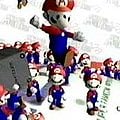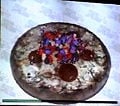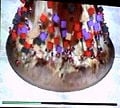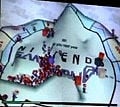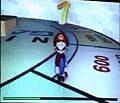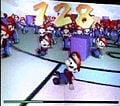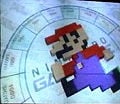Super Mario 128
- This article is about the tech demo. For the Event Match from Super Smash Bros. Melee, see Super Smash Bros. Melee#Event Match.
- “What happened to Super Mario 128? Most of you already played it…”
- —Shigeru Miyamoto
Super Mario 128 is the name of a series of projects by Nintendo to create a sequel to Super Mario 64, much like the canceled game Super Mario 64 2. While initially named in January 1997,[1] it was first shown as a tech demo at Spaceworld 2000, the project experimented with new technology and ideas to incorporate into later games. A demo of the project was released by Nintendo. The demo featured 128 Marios on screen at once. Other features of the demo included the use of "rapid generation", later used in Pikmin[2], and "sphere walking", later used in The Legend of Zelda: Twilight Princess[citation needed] and Super Mario Galaxy[3]. Super Mario 128 has been confirmed to be unrelated to Super Mario Sunshine.[4]
During his keynote speech at the Game Developers Conference 2007, Shigeru Miyamoto revealed what eventually happened to Super Mario 128. "What happened to Mario 128?" said Miyamoto at the end of his keynote, "most of you already played it...," then the screen showed that Mario 128 equaled Pikmin.
References in other games
- A mission in Super Smash Bros. Melee is titled "Super Mario 128", where the player must defeat 128 tiny Marios.
- The idea to have 128 Marios at once in the demo may have inspired the idea of Luiginoids in the 3DS game Mario & Luigi: Dream Team, where the player uses clones of Luigi to navigate through various areas.
Gallery
It has been requested that more images be uploaded for this article. Remove this notice only after the additional image(s) have been added.
External links
References
- ^ Nintendo Power (January 1997). "Miyamoto Interviews". Miyamoto Shrine. Retrieved September 19, 2018.
- ^ Martin, Matt (March 9, 2007). "GDC: Shigeru Miyamoto's Keynote Speech". GamesIndustry.biz. Retrieved September 19, 2018.
- ^ IGN (August 21, 2006). "Miyamoto Opens the Vault". IGN. Retrieved September 19, 2018.
- ^ Davies, Paul (May 16, 2003). "E3 2003: Miyamoto: the interview". Computer and Video Games. Retrieved September 19, 2018.
